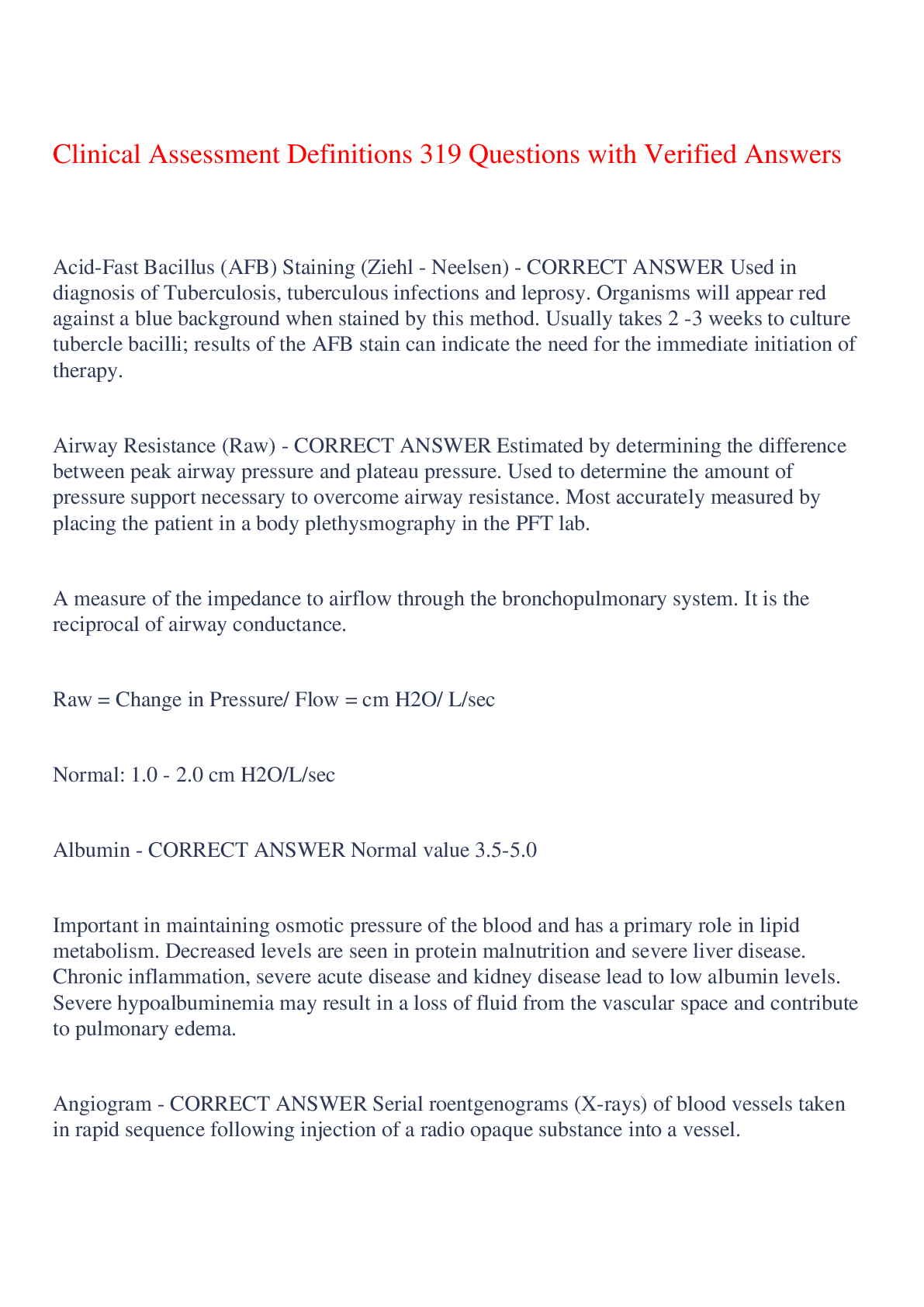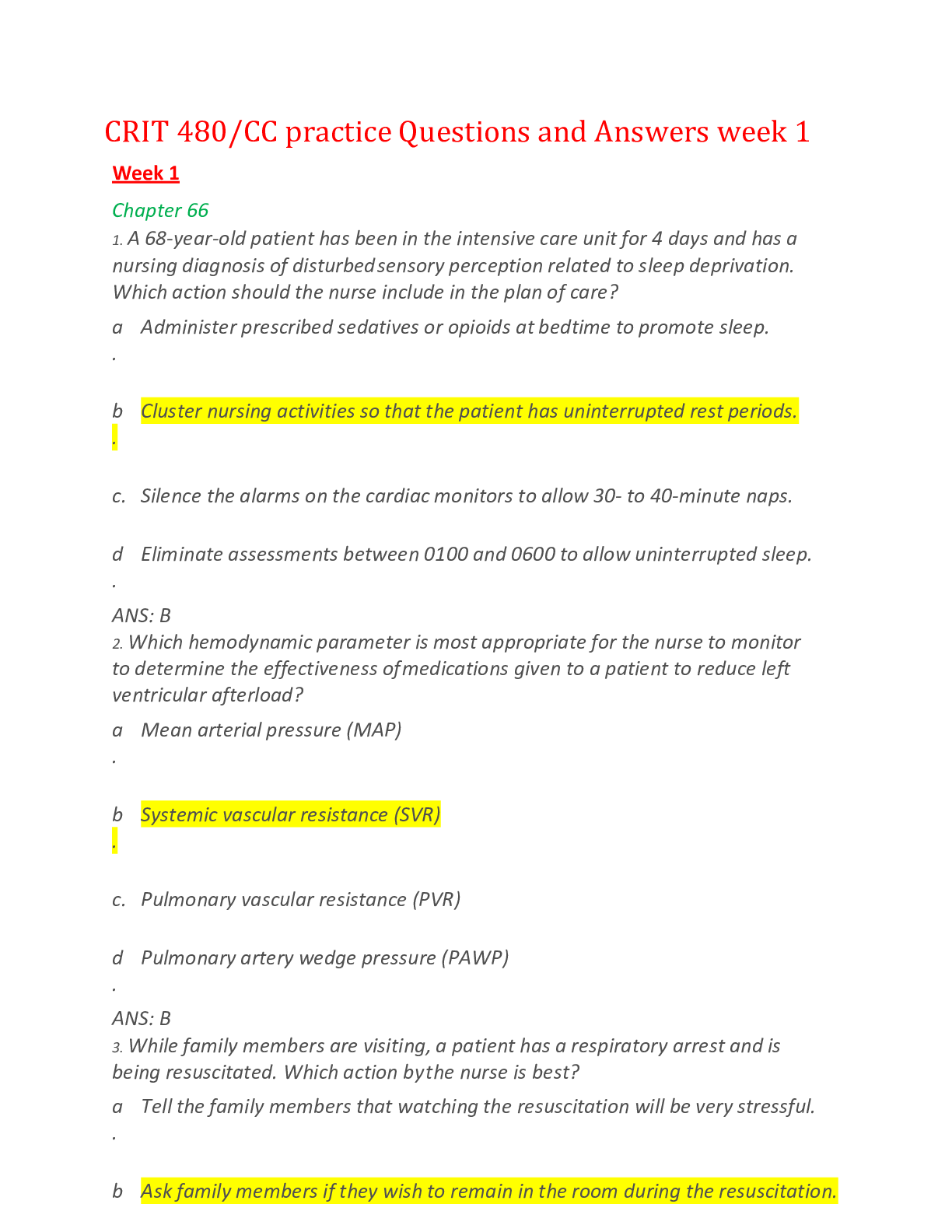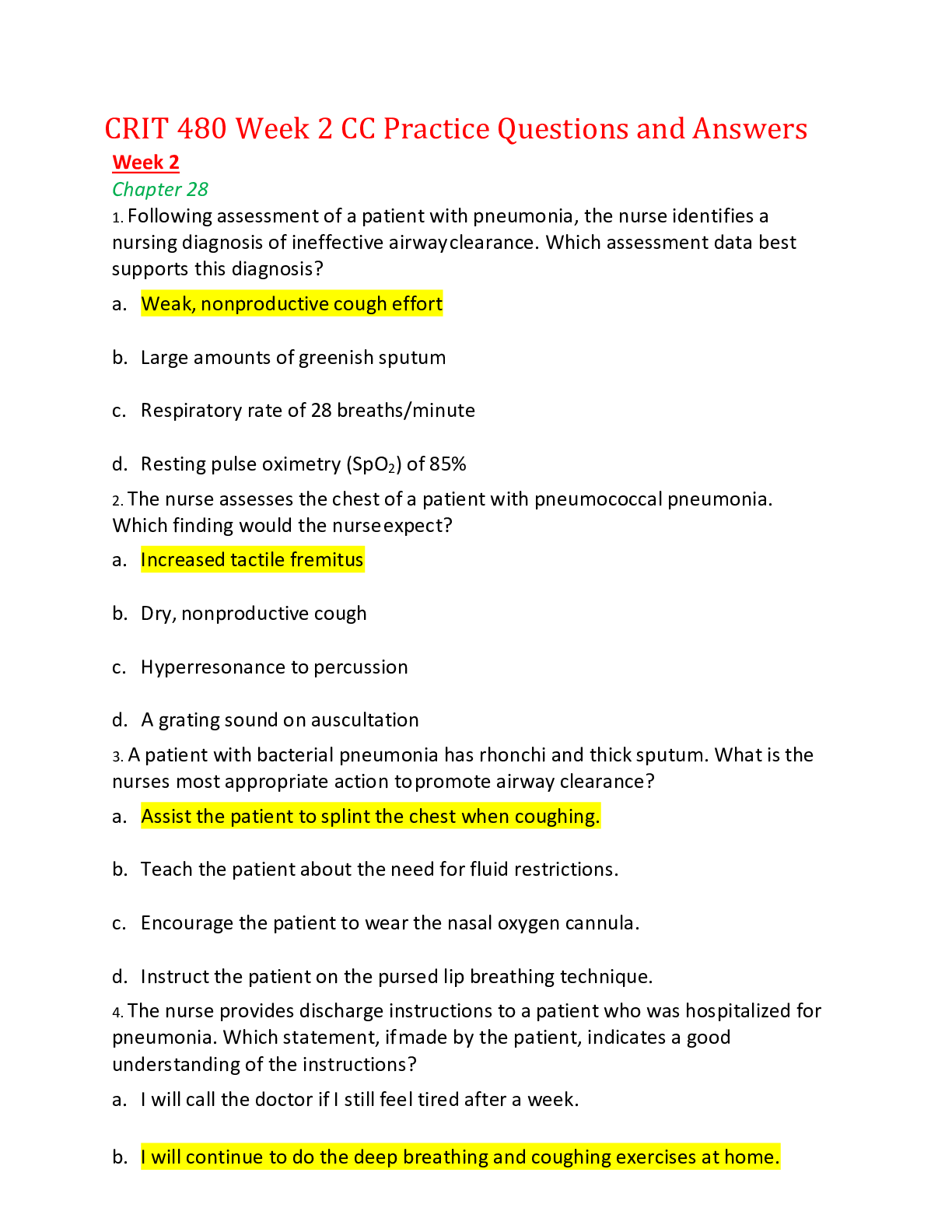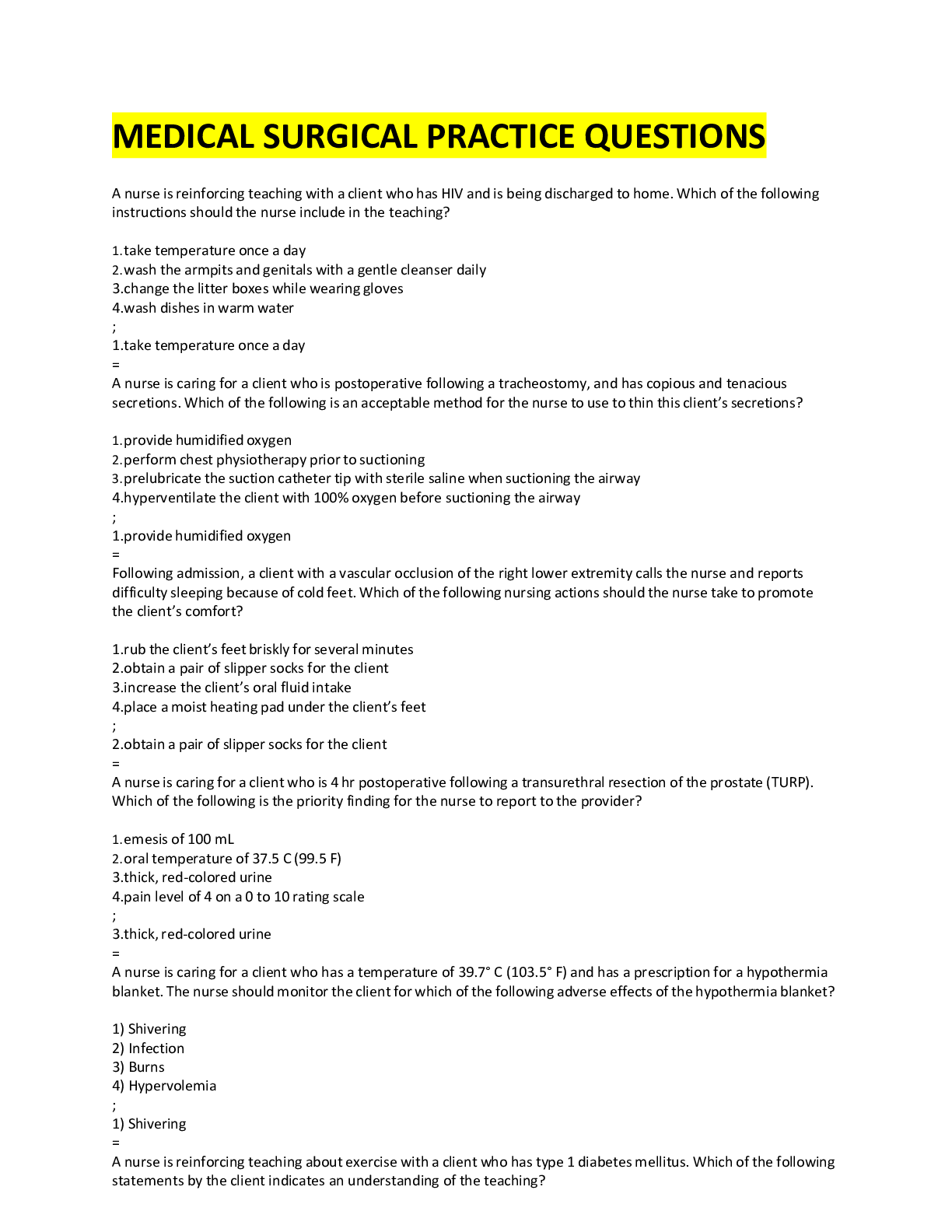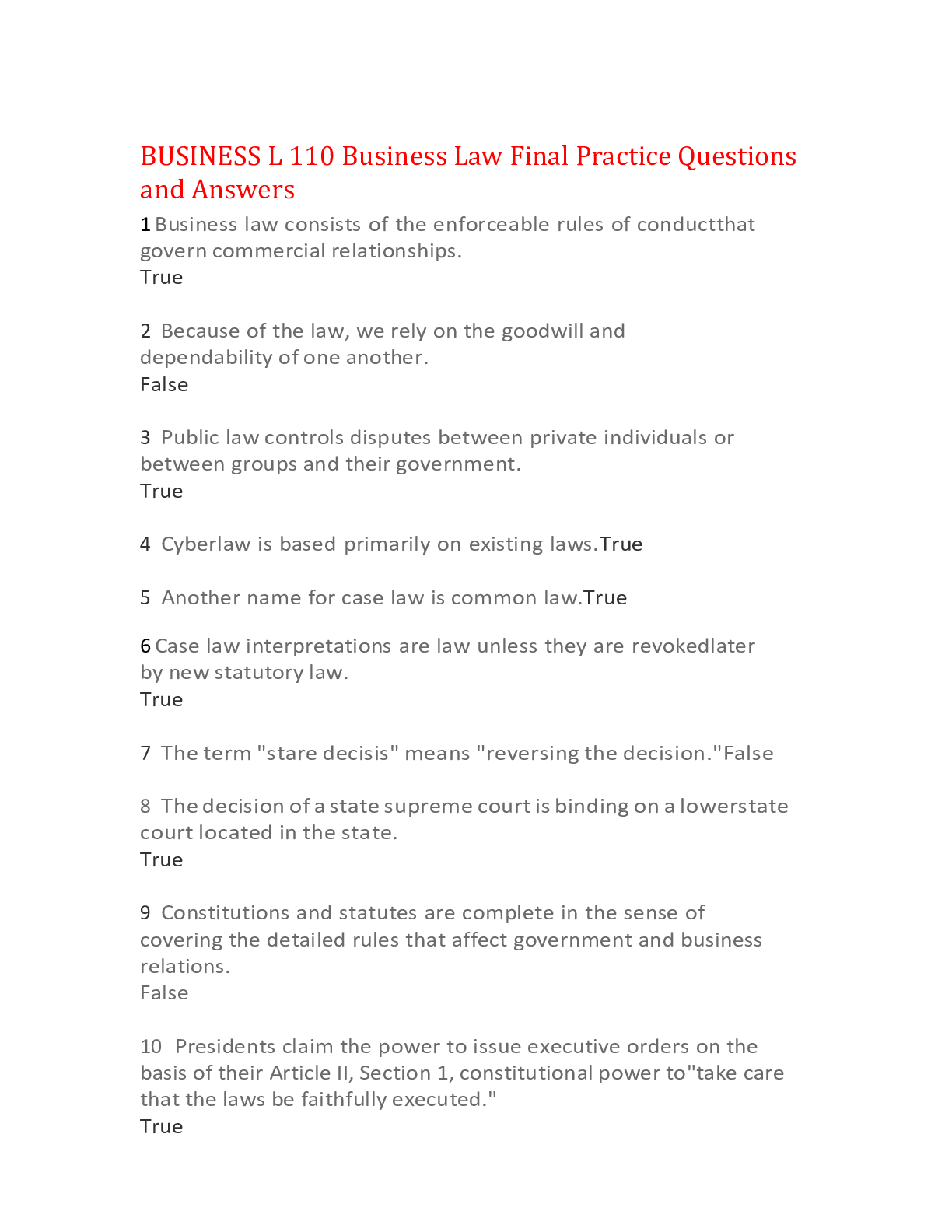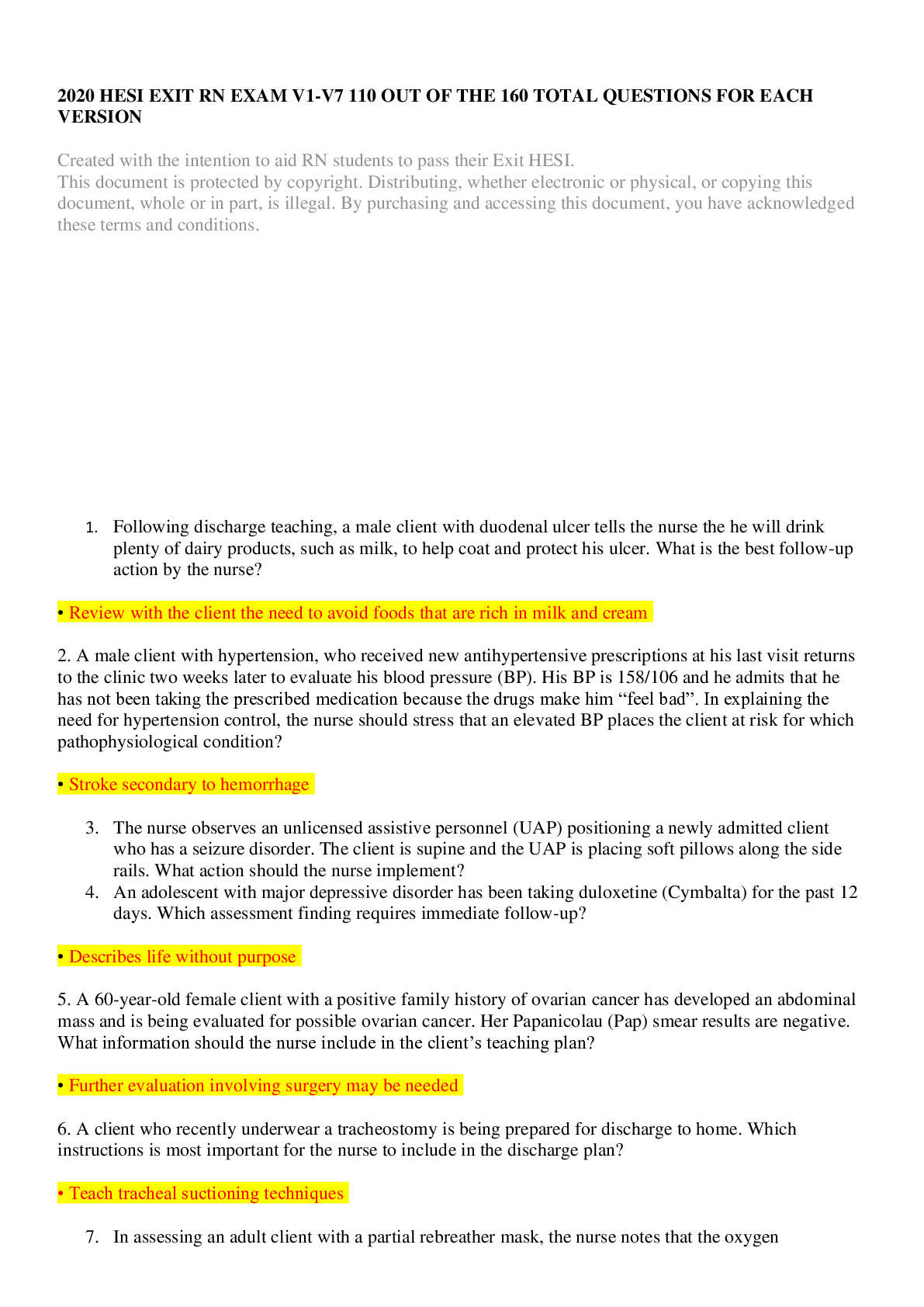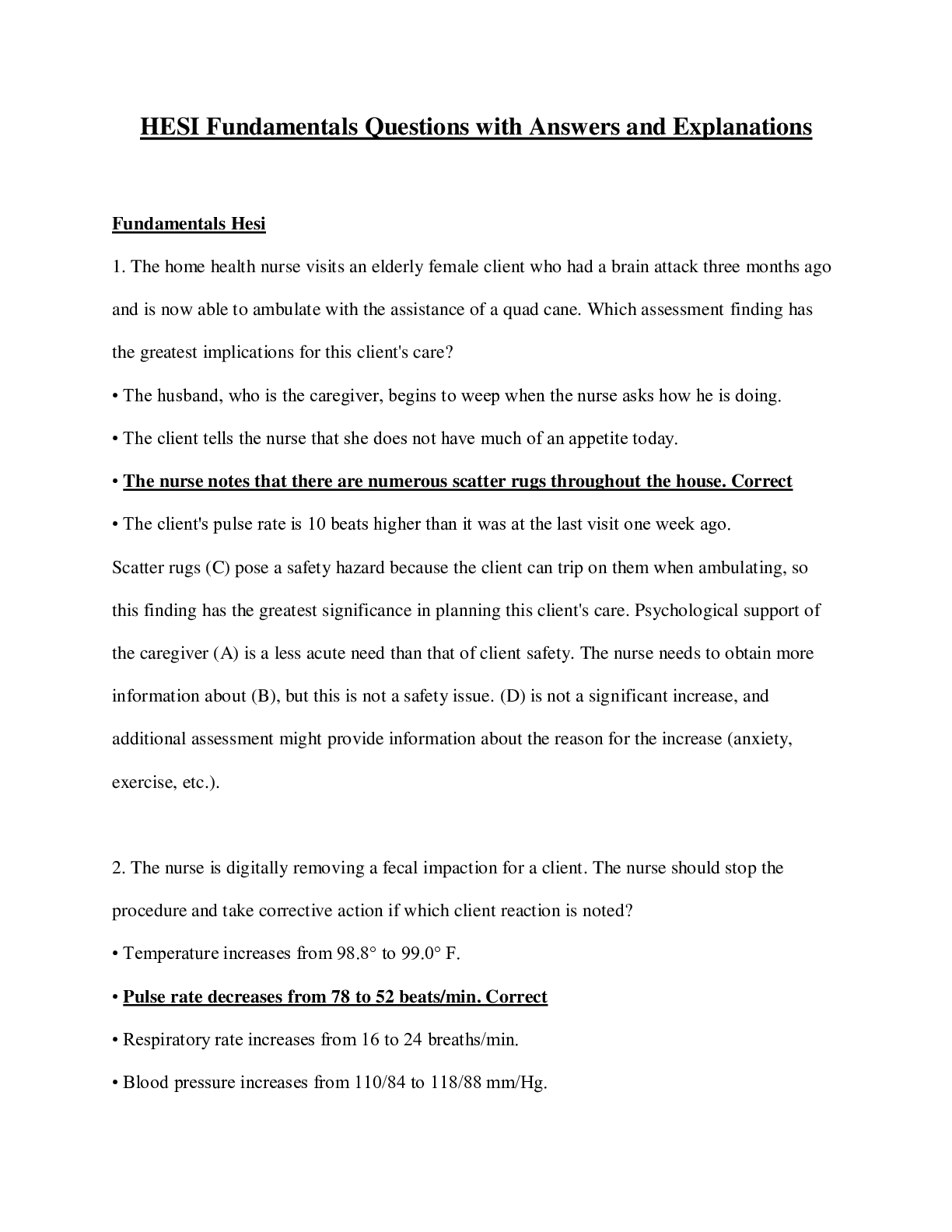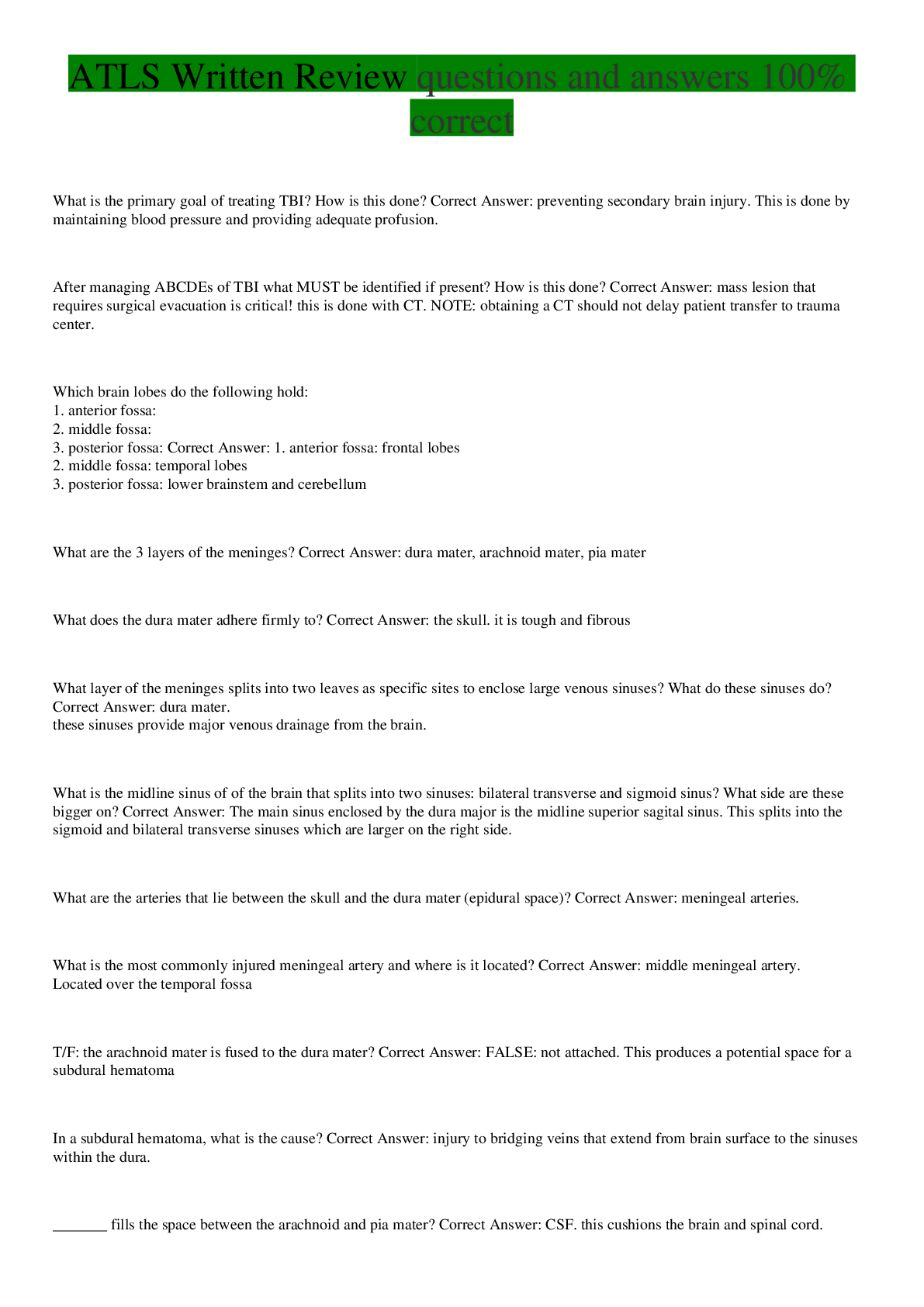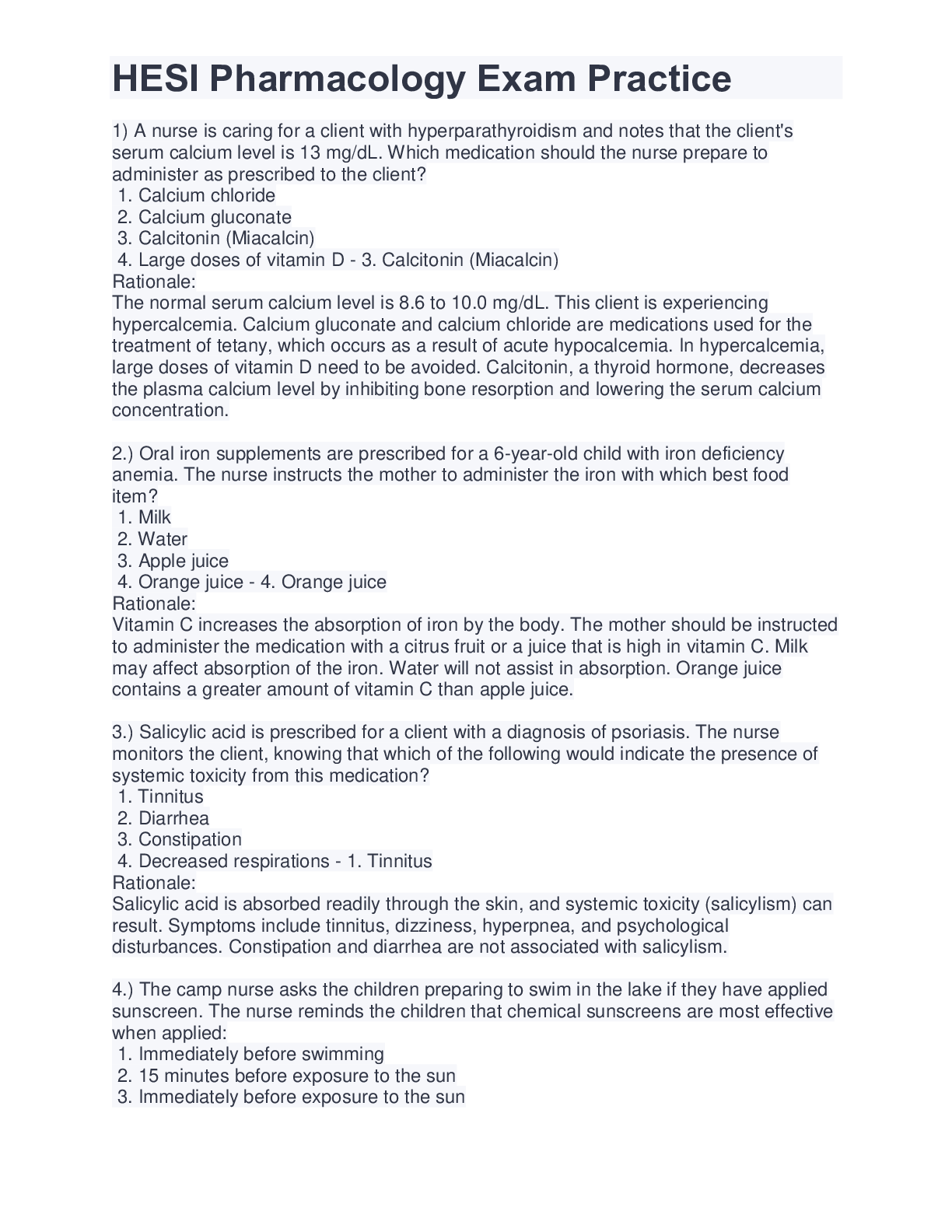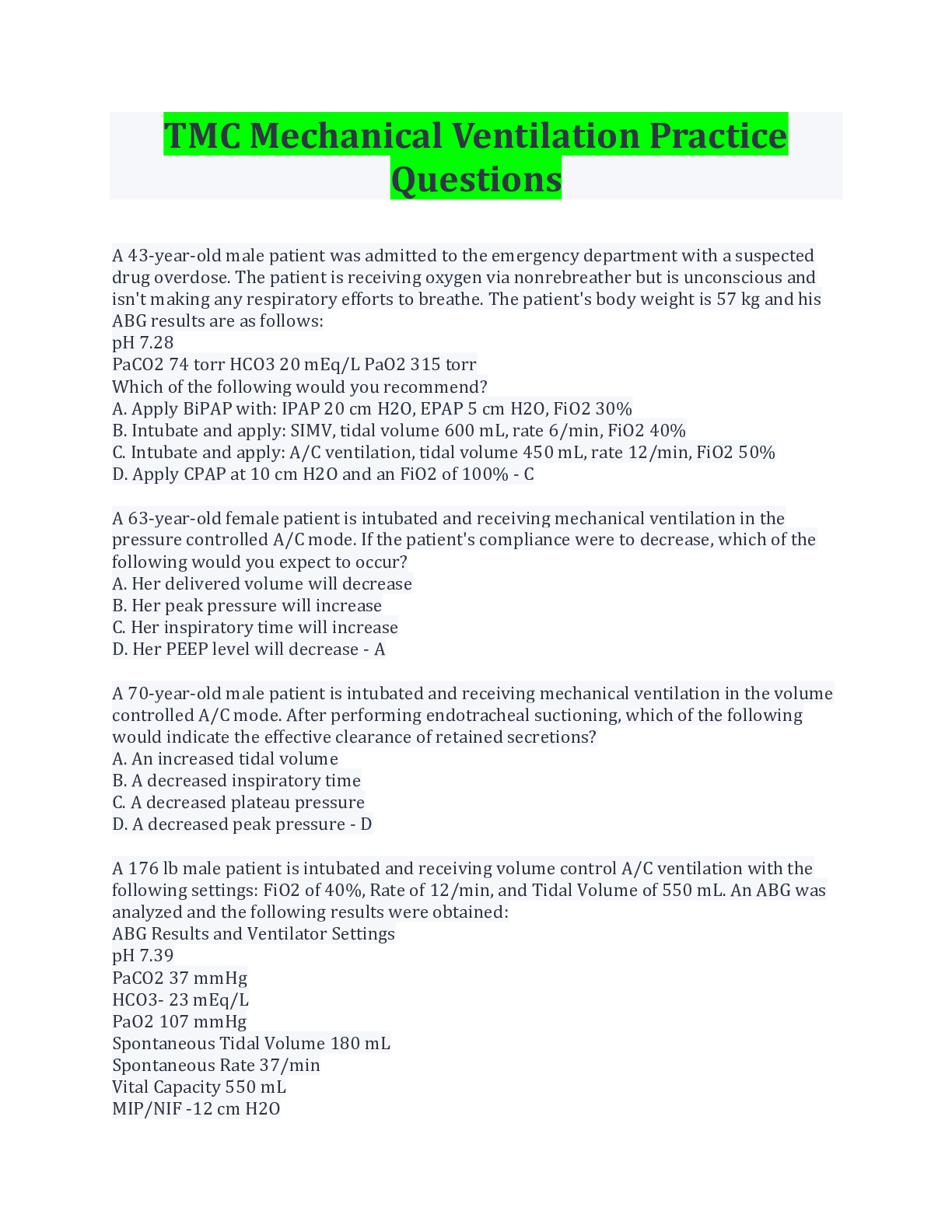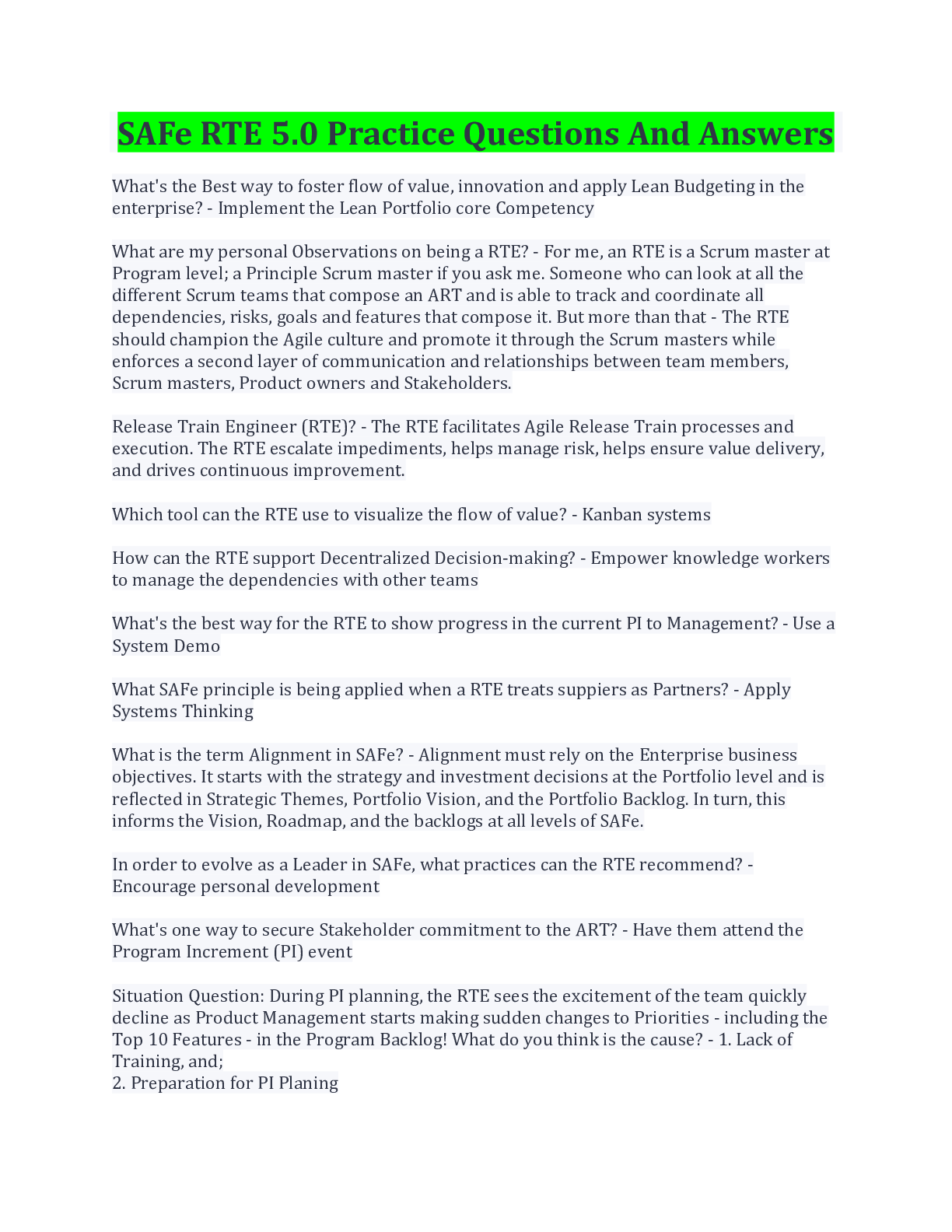CRIT 480 Week 3 CC Practice Questions and Answers,100% CORRECT
Document Content and Description Below
CRIT 480 Week 3 CC Practice Questions and Answers Week 3 Chapter 32 1. After noting a pulse deficit when assessing a 74-year-old patient who has just arrived in the emergency department, the nurse ... will anticipate that the patient may require a. emergent cardioversion. b. a cardiac catheterization. c. hourly blood pressure (BP) checks. d. electrocardiographic (ECG) monitoring. 2. When reviewing the 12-lead electrocardiograph (ECG) for a healthy 79-year-old patient who is having an annual physical examination, what will be of most concern to the nurse? a. The PR interval is 0.21 seconds. b. The QRS duration is 0.13 seconds. c. There is a right bundle-branch block. d. The heart rate (HR) is 42 beats/minute. 3. During a physical examination of a 74-year-old patient, the nurse palpates the point of maximal impulse (PMI) in the sixth intercostal space lateral to the left midclavicular line. The most appropriate action for the nurse to take next will be to a. ask the patient about risk factors for atherosclerosis. b. document that the PMI is in the normal anatomic location. c. auscultate both the carotid arteries for the presence of a bruit. d. assess the patient for symptoms of left ventricular hypertrophy. 4. To auscultate for S3 or S4 gallops in the mitral area, the nurse listens with the a. bell of the stethoscope with the patient in the left lateral position. b. diaphragm of the stethoscope with the patient in a supine position. c. bell of the stethoscope with the patient sitting and leaning forward. d. diaphragm of the stethoscope with the patient lying flat on the left side. 5. To determine the effects of therapy for a patient who is being treated for heart failure, which laboratory result will the nurse plan to review? a. Troponin b. Homocysteine (Hcy) c. Low-density lipoprotein (LDL) d. B-type natriuretic peptide (BNP) 6. While doing the admission assessment for a thin 76-year-old patient, the nurse observes pulsation of the abdominal aorta in the epigastric area. Which action should the nurse take? a. Teach the patient about aneurysms. b. Notify the hospital rapid response team. c. Instruct the patient to remain on bed rest. d. Document the finding in the patient chart. 7. A patient is scheduled for a cardiac catheterization with coronary angiography. Before the test, the nurse informs the patient that a. it will be important to lie completely still during the procedure. b. a flushed feeling may be noted when the contrast dye is injected. c. monitored anesthesia care will be provided during the procedure. d. arterial pressure monitoring will be required for 24 hours after the test. 8. While assessing a patient who was admitted with heart failure, the nurse notes that the patient has jugular venous distention (JVD) when lying flat in bed. Which action should the nurse take next? a. Document this finding in the patients record. b. Obtain vital signs, including oxygen saturation. c. Have the patient perform the Valsalva maneuver. d. Observe for JVD with the patient upright at 45 degrees. 9. The nurse teaches the patient being evaluated for rhythm disturbances with a Holter monitor to a. connect the recorder to a computer once daily. b. exercise more than usual while the monitor is in place. c. remove the electrodes when taking a shower or tub bath. d. keep a diary of daily activities while the monitor is worn. 10. When auscultating over the patients abdominal aorta, the nurse hears a humming sound. The nurse documents this finding as a a. thrill. b. bruit. c. murmur. d. normal finding. 11. The nurse has received the laboratory results for a patient who developed chest pain 4 hours ago and may be having a myocardial infarction. The most important laboratory result to review will be a. myoglobin. b. low-density lipoprotein (LDL) cholesterol. c. troponins T and I. d. creatine kinase-MB (CK-MB). 12. When assessing a newly admitted patient, the nurse notes a murmur along the left sternal border. To document more information about the murmur, which action will the nurse take next? a. Find the point of maximal impulse. b. Determine the timing of the murmur. c. Compare the apical and radial pulse rates. d. Palpate the quality of the peripheral pulses. 13. The nurse hears a murmur between the S1 and S2 heart sounds at the patients left fifth intercostal space and midclavicular line. How will the nurse record this information? a. Systolic murmur heard at mitral area b. Systolic murmur heard at Erbs point c. Diastolic murmur heard at aortic area d. Diastolic murmur heard at the point of maximal impulse 14. A registered nurse (RN) is observing a student nurse who is doing a physical assessment on a patient. The RN will need to intervene immediately if the student nurse a. presses on the skin over the tibia for 10 seconds to check for edema. b. palpates both carotid arteries simultaneously to compare pulse quality. c. documents a murmur heard along the right sternal border as a pulmonic murmur. d. places the patient in the left lateral position to check for the point of maximal impulse. 15. Which action will the nurse implement for a patient who arrives for a calcium-scoring CT scan? a. Insert an IV catheter. b. Administer oral sedative medications. c. Teach the patient about the procedure. d. Confirm that the patient has been fasting. 16. Which information obtained by the nurse who is admitting the patient for magnetic resonance imaging (MRI) will be most important to report to the health care provider before the MRI? a. The patient has an allergy to shellfish. b. The patient has a history of atherosclerosis. c. The patient has a permanent ventricular pacemaker. d. The patient took all the prescribed cardiac medications today. 17. When the nurse is monitoring a patient who is undergoing exercise (stress) testing on a treadmill, which assessment finding requires the most rapid action by the nurse? a. Patient complaint of feeling tired b. Pulse change from 87 to 101 beats/minute c. Blood pressure (BP) increase from 134/68 to 150/80 mm Hg d. Newly inverted T waves on the electrocardiogram 18. The standard policy on the cardiac unit states, Notify the health care provider for mean arterial pressure (MAP) less than 70 mm Hg. The nurse will need to call the health care provider about the a. postoperative patient with a BP of 116/42. b. newly admitted patient with a BP of 150/87. c. patient with left ventricular failure who has a BP of 110/70. d. patient with a myocardial infarction who has a BP of 140/86. 19. When admitting a patient for a cardiac catheterization and coronary angiogram, which information about the patient is most important for the nurse to communicate to the health care provider? a. The patients pedal pulses are +1. b. The patient is allergic to shellfish. c. The patient had a heart attack a year ago. d. The patient has not eaten anything today. 20. A transesophageal echocardiogram (TEE) is ordered for a patient with possible endocarditis. Which action included in the standard TEE orders will the nurse need to accomplish first? a. Start an IV line. b. Place the patient on NPO status. c. Administer O2 per nasal cannula. d. Give lorazepam (Ativan) 1 mg IV. 21. The nurse and unlicensed assistive personnel (UAP) on the telemetry unit are caring for four patients. Which nursing action can be delegated to the UAP? a. Teaching a patient scheduled for exercise electrocardiography about the procedure b. Placing electrodes in the correct position for a patient who is to receive ECG monitoring c. Checking the catheter insertion site for a patient who is recovering from a coronary angiogram d. Monitoring a patient who has just returned to the unit after a transesophageal echocardiogram 22. The nurse is reviewing the laboratory results for newly admitted patients on the cardiovascular unit. Which patient laboratory result is most important to communicate as soon as possible to the health care provider? a. Patient whose triglyceride level is high b. Patient who has very low homocysteine level c. Patient with increase in troponin T and troponin I level d. Patient with elevated high-sensitivity C-reactive protein level 23. When the nurse is screening patients for possible peripheral arterial disease, indicate where the posterior tibial artery will be palpated. a. 1 b. 2 c. 3 d. 4 Chapter 34 1. When developing a teaching plan for a 61-year-old man with the following risk factors for coronary artery disease (CAD), the nurse should focus on the a. family history of coronary artery disease. b. increased risk associated with the patients gender. c. increased risk of cardiovascular disease as people age. d. elevation of the patients low-density lipoprotein (LDL) level. 2. Which nursing intervention will be most effective when assisting the patient with coronary artery disease (CAD) to make appropriate dietary changes? a. Give the patient a list of low-sodium, low-cholesterol foods that should be included in the diet. b. Emphasize the increased risk for heart problems unless the patient makes the dietary changes. c. Help the patient modify favorite high-fat recipes by using monosaturated oils when possible. d. Inform the patient that a diet containing no saturated fat and minimal salt will be necessary. 3. Which assessment data collected by the nurse who is admitting a patient with chest pain suggest that the pain is caused by an acute myocardial infarction (AMI)? a. The pain increases with deep breathing. b. The pain has lasted longer than 30 minutes. c. The pain is relieved after the patient takes nitroglycerin. d. The pain is reproducible when the patient raises the arms. 4. Which information given by a patient admitted with chronic stable angina will help the nurse confirm this diagnosis? a. The patient states that the pain wakes me up at night. b. The patient rates the pain at a level 3 to 5 (0 to 10 scale). c. The patient states that the pain has increased in frequency over the last week. d. The patient states that the pain goes away with one sublingual nitroglycerin tablet. 5. After the nurse has finished teaching a patient about the use of sublingual nitroglycerin (Nitrostat), which patient statement indicates that the teaching has been effective? a. I can expect some nausea as a side effect of nitroglycerin. b. I should only take the nitroglycerin if I start to have chest pain. c. I will call an ambulance if I still have pain after taking 3 nitroglycerin 5 minutes apart. d. Nitroglycerin helps prevent a clot from forming and blocking blood flow to my heart. 6. Which statement made by a patient with coronary artery disease after the nurse has completed teaching about therapeutic lifestyle changes (TLC) diet indicates that further teaching is needed? a. I will switch from whole milk to 1% milk. b. I like salmon and I will plan to eat it more often. c. I can have a glass of wine with dinner if I want one. d. I will miss being able to eat peanut butter sandwiches. 7. After the nurse teaches the patient about the use of carvedilol (Coreg) in preventing anginal episodes, which statement by a patient indicates that the teaching has been effective? a. Carvedilol will help my heart muscle work harder. b. It is important not to suddenly stop taking the carvedilol. c. I can expect to feel short of breath when taking carvedilol. d. Carvedilol will increase the blood flow to my heart muscle. 8. A patient who has had chest pain for several hours is admitted with a diagnosis of rule out acute myocardial infarction (AMI). Which laboratory test should the nurse monitor to help determine whether the patient has had an AMI? a. Myoglobin b. Homocysteine c. C-reactive protein d. Cardiac-specific troponin 9. Diltiazem (Cardizem) is ordered for a patient with newly diagnosed Prinzmetals (variant) angina. When teaching the patient, the nurse will include the information that diltiazem will a. reduce heart palpitations. b. decrease spasm of the coronary arteries. c. increase the force of the heart contractions. d. help prevent plaque from forming in the coronary arteries. 10. The nurse will suspect that the patient with stable angina is experiencing a side effect of the prescribed metoprolol (Lopressor) if the a. patient is restless and agitated. b. blood pressure is 90/54 mm Hg. c. patient complains about feeling anxious. d. cardiac monitor shows a heart rate of 61 beats/minute. 11. Nadolol (Corgard) is prescribed for a patient with chronic stable angina and left ventricular dysfunction. To determine whether the drug is effective, the nurse will monitor for a. decreased blood pressure and heart rate. b. fewer complaints of having cold hands and feet. c. improvement in the strength of the distal pulses. d. the ability to do daily activities without chest pain. 12. Heparin is ordered for a patient with a nonST-segment-elevation myocardial infarction (NSTEMI). What is the purpose of the heparin? a. Heparin enhances platelet aggregation. b. Heparin decreases coronary artery plaque size. c. Heparin prevents the development of new clots in the coronary arteries. d. Heparin dissolves clots that are blocking blood flow in the coronary arteries. 13. When titrating IV nitroglycerin (Tridil) for a patient with a myocardial infarction (MI), which action will the nurse take to evaluate the effectiveness of the medication? a. Monitor heart rate. b. Ask about chest pain. c. Check blood pressure. d. Observe for dysrhythmias. 14. A patient with ST-segment elevation in three contiguous electrocardiographic (ECG) leads is admitted to the emergency department (ED) and diagnosed as having an ST-segment-elevation myocardial infarction (STEMI). Which question should the nurse ask to determine whether the patient is a candidate for thrombolytic therapy? a. Do you have any allergies? b. Do you take aspirin on a daily basis? c. What time did your chest pain begin? d. Can you rate your chest pain using a 0 to 10 scale? 15. Following an acute myocardial infarction (AMI), a patient ambulates in the hospital hallway. When the nurse is evaluating the patients response to the activity, which assessment data would indicate that the exercise level should be decreased? a. Blood pressure (BP) changes from 118/60 to 126/68 mm Hg. b. Oxygen saturation drops from 99% to 95%. c. Heart rate increases from 66 to 92 beats/minute. d. Respiratory rate goes from 14 to 20 breaths/minute. 16. During the administration of the thrombolytic agent to a patient with an acute myocardial infarction (AMI), the nurse should stop the drug infusion if the patient experiences a. bleeding from the gums. b. increase in blood pressure. c. a decrease in level of consciousness. d. a nonsustained episode of ventricular tachycardia. 17. A patient is recovering from a myocardial infarction (MI) and develops chest pain on day 3 that increases when taking a deep breath and is relieved by leaning forward. Which action should the nurse take next? a. Assess the feet for pedal edema. b. Palpate the radial pulses bilaterally. c. Auscultate for a pericardial friction rub. d. Check the heart monitor for dysrhythmias. 18. In preparation for discharge, the nurse teaches a patient with chronic stable angina how to use the prescribed short-acting and long-acting nitrates. Which patient statement indicates that the teaching has been effective? a. I will check my pulse rate before I take any nitroglycerin tablets. b. I will put the nitroglycerin patch on as soon as I get any chest pain. c. I will stop what I am doing and sit down before I put the nitroglycerin under my tongue. d. I will be sure to remove the nitroglycerin patch before taking any sublingual nitroglycerin. 19. Three days after experiencing a myocardial infarction (MI), a patient who is scheduled for discharge asks for assistance with hygiene activities, saying, I am too nervous to take care of myself. Based on this information, which nursing diagnosis is appropriate? a. Ineffective coping related to anxiety b. Activity intolerance related to weakness c. Denial related to lack of acceptance of the MI d. Disturbed personal identity related to understanding of illness 20. When caring for a patient who is recovering from a sudden cardiac death (SCD) event and has no evidence of an acute myocardial infarction (AMI), the nurse will anticipate teaching the patient that a. sudden cardiac death events rarely reoccur. b. additional diagnostic testing will be required. c. long-term anticoagulation therapy will be needed. d. limited physical activity after discharge will be needed to prevent future events. 21. A few days after experiencing a myocardial infarction (MI) and successful percutaneous coronary intervention, the patient states, I just had a little chest pain. As soon as I get out of here, Im going for my vacation as planned. Which reply would be most appropriate for the nurse to make? a. What do you think caused your chest pain? b. Where are you planning to go for your vacation? c. Sometimes plans need to change after a heart attack. d. Recovery from a heart attack takes at least a few weeks. 22. When evaluating the effectiveness of preoperative teaching with a patient scheduled for coronary artery bypass graft (CABG) surgery using the internal mammary artery, the nurse determines that additional teaching is needed when the patient says which of the following? a. They will circulate my blood with a machine during the surgery. b. I will have small incisions in my leg where they will remove the vein. c. They will use an artery near my heart to go around the area that is blocked. d. I will need to take an aspirin every day after the surgery to keep the graft open. 23. A patient who is recovering from an acute myocardial infarction (AMI) asks the nurse about when sexual intercourse can be resumed. Which response by the nurse is best? a. Most patients are able to enjoy intercourse without any complications. b. Sexual activity uses about as much energy as climbing two flights of stairs. c. The doctor will provide sexual guidelines when your heart is strong enough. d. Holding and cuddling are good ways to maintain intimacy after a heart attack. 24. A patient with hyperlipidemia has a new order for colesevelam (Welchol). Which nursing action is most appropriate when giving the medication? a. Have the patient take this medication with an aspirin. b. Administer the medication at the patients usual bedtime. c. Have the patient take the colesevelam with a sip of water. d. Give the patients other medications 2 hours after the colesevelam. 25. The nurse is caring for a patient who was admitted to the coronary care unit following an acute myocardial infarction (AMI) and percutaneous coronary intervention the previous day. Teaching for this patient would include a. when cardiac rehabilitation will begin. b. the typical emotional responses to AMI. c. information regarding discharge medications. d. the pathophysiology of coronary artery disease. 26. A patient who has recently started taking pravastatin (Pravachol) and niacin (Nicobid) reports the following symptoms to the nurse. Which is most important to communicate to the health care provider? a. Generalized muscle aches and pains b. Dizziness when changing positions quickly c. Nausea when taking the drugs before eating d. Flushing and pruritus after taking the medications 27. A patient who is being admitted to the emergency department with intermittent chest pain gives the following list of medications to the nurse. Which medication has the most immediate implications for the patients care? a. Sildenafil (Viagra) b. Furosemide (Lasix) c. Captopril (Capoten) d. Warfarin (Coumadin) 28. Which assessment finding by the nurse caring for a patient who has had coronary artery bypass grafting using a right radial artery graft is most important to communicate to the health care provider? a. Complaints of incisional chest pain b. Pallor and weakness of the right hand c. Fine crackles heard at both lung bases d. Redness on both sides of the sternal incision 29. When caring for a patient who has just arrived on the medical-surgical unit after having cardiac catheterization, which nursing intervention should the nurse delegate to a licensed practical/vocational nurse (LPN/LVN)? a. Give the scheduled aspirin and lipid-lowering medication. b. Perform the initial assessment of the catheter insertion site. c. Teach the patient about the usual postprocedure plan of care. d. Titrate the heparin infusion according to the agency protocol. 30. Which electrocardiographic (ECG) change is most important for the nurse to report to the health care provider when caring for a patient with chest pain? a. Inverted P wave b. Sinus tachycardia c. ST-segment elevation d. First-degree atrioventricular block 31. When caring for a patient with acute coronary syndrome who has returned to the coronary care unit after having angioplasty with stent placement, the nurse obtains the following assessment data. Which data indicate the need for immediate action by the nurse? a. Heart rate 102 beats/min b. Pedal pulses 1+ bilaterally c. Blood pressure 103/54 mm Hg d. Chest pain level 7 on a 0 to 10 point scale 32. A patient admitted to the coronary care unit (CCU) with an ST-segment-elevation myocardial infarction (STEMI) is restless and anxious. The blood pressure is 86/40 and heart rate is 123. Based on this information, which nursing diagnosis is a priority for the patient? a. Acute pain related to myocardial infarction b. Anxiety related to perceived threat of death c. Stress overload related to acute change in health d. Decreased cardiac output related to cardiogenic shock 33. When admitting a patient with a nonST-segment-elevation myocardial infarction (NSTEMI) to the intensive care unit, which action should the nurse perform first? a. Obtain the blood pressure. b. Attach the cardiac monitor. c. Assess the peripheral pulses. d. Auscultate the breath sounds. 34. Which information about a patient who has been receiving thrombolytic therapy for an acute myocardial infarction (AMI) is most important for the nurse to communicate to the health care provider? a. No change in the patients chest pain b. An increase in troponin levels from baseline c. A large bruise at the patients IV insertion site d. A decrease in ST-segment elevation on the electrocardiogram 35. The nurse obtains the following data when assessing a patient who experienced an ST-segment-elevation myocardial infarction (STEMI) 2 days previously. Which information is most important to report to the health care provider? a. The troponin level is elevated. b. The patient denies ever having a heart attack. c. Bilateral crackles are auscultated in the mid-lower lobes. d. The patient has occasional premature atrial contractions (PACs). 36. A patient had a nonST-segment-elevation myocardial infarction (NSTEMI) 3 days ago. Which nursing intervention included in the plan of care is most appropriate for the registered nurse (RN) to delegate to an experienced licensed practical/vocational nurse (LPN/LVN)? a. Evaluation of the patients response to walking in the hallway b. Completion of the referral form for a home health nurse follow-up c. Education of the patient about the pathophysiology of heart disease d. Reinforcement of teaching about the purpose of prescribed medications 37. A patient who has chest pain is admitted to the emergency department (ED) and all of the following are ordered. Which one should the nurse arrange to be completed first? a. Chest x-ray b. Troponin level c. Electrocardiogram (ECG) d. Insertion of a peripheral IV 38. After receiving change-of-shift report about the following four patients, which patient should the nurse assess first? a. 39-year-old with pericarditis who is complaining of sharp, stabbing chest pain b. 56-year-old with variant angina who is to receive a dose of nifedipine (Procardia) c. 65-year-old who had a myocardial infarction (MI) 4 days ago and is anxious about the planned discharge d. 59-year-old with unstable angina who has just returned to the unit after having a percutaneous coronary intervention (PCI) 39. To improve the physical activity level for a mildly obese 71-year-old patient, which action should the nurse plan to take? a. Stress that weight loss is a major benefit of increased exercise. b. Determine what kind of physical activities the patient usually enjoys. c. Tell the patient that older adults should exercise for no more than 20 minutes at a time. d. Teach the patient to include a short warm-up period at the beginning of physical activity. 40. Which patient at the cardiovascular clinic requires the most immediate action by the nurse? a. Patient with type 2 diabetes whose current blood glucose level is 145 mg/dL b. Patient with stable angina whose chest pain has recently increased in frequency c. Patient with familial hypercholesterolemia and a total cholesterol of 465 mg/dL d. Patient with chronic hypertension whose blood pressure today is 172/98 mm Hg 41. A patient with diabetes mellitus and chronic stable angina has a new order for captopril (Capoten). The nurse should teach the patient that the primary purpose of captopril is to a. lower heart rate. b. control blood glucose levels. c. prevent changes in heart muscle. d. reduce the frequency of chest pain. 42. After reviewing information shown in the accompanying figure from the medical records of a 43-year-old, which risk factor modification for coronary artery disease should the nurse include in patient teaching? a. Importance of daily physical activity b. Effect of weight loss on blood pressure c. Dietary changes to improve lipid levels d. Ongoing cardiac risk associated with history of tobacco use 43. After reviewing a patients history, vital signs, physical assessment, and laboratory data, which information shown in the accompanying figure is most important for the nurse to communicate to the health care provider? a. Q waves on ECG b. Elevated troponin levels c. Fever and hyperglycemia d. Tachypnea and crackles in lungs ANS: D Chapter 36 1. To determine whether there is a delay in impulse conduction through the atria, the nurse will measure the duration of the patients a. P wave. b. Q wave. c. P-R interval. d. QRS complex. 2. The nurse needs to quickly estimate the heart rate for a patient with a regular heart rhythm. Which method will be best to use? a. Count the number of large squares in the R-R interval and divide by 300. b. Print a 1-minute electrocardiogram (ECG) strip and count the number of QRS complexes. c. Calculate the number of small squares between one QRS complex and the next and divide into 1500. d. Use the 3-second markers to count the number of QRS complexes in 6 seconds and multiply by 10. 3. A patient has a junctional escape rhythm on the monitor. The nurse will expect the patient to have a heart rate of beats/minute. a. 15 to 20 b. 20 to 40 c. 40 to 60 d. 60 to 100 4. The nurse obtains a rhythm strip on a patient who has had a myocardial infarction and makes the following analysis: no visible P waves, P-R interval not measurable, ventricular rate 162, R-R interval regular, and QRS complex wide and distorted, QRS duration 0.18 second. The nurse interprets the patients cardiac rhythm as a. atrial flutter. b. sinus tachycardia. c. ventricular fibrillation. d. ventricular tachycardia. 5. The nurse notes that a patients cardiac monitor shows that every other beat is earlier than expected, has no visible P wave, and has a QRS complex that is wide and bizarre in shape. How will the nurse document the rhythm? a. Ventricular couplets b. Ventricular bigeminy c. Ventricular R-on-T phenomenon d. Multifocal premature ventricular contractions 6. A patient has a normal cardiac rhythm and a heart rate of 72 beats/minute. The nurse determines that the P-R interval is 0.24 seconds. The most appropriate intervention by the nurse would be to a. notify the health care provider immediately. b. give atropine per agency dysrhythmia protocol. c. prepare the patient for temporary pacemaker insertion. d. document the finding and continue to monitor the patient. 7. A patient who was admitted with a myocardial infarction experiences a 45-second episode of ventricular tachycardia, then converts to sinus rhythm with a heart rate of 98 beats/minute. Which of the following actions should the nurse take next? a. Immediately notify the health care provider. b. Document the rhythm and continue to monitor the patient. c. Perform synchronized cardioversion per agency dysrhythmia protocol. d. Prepare to give IV amiodarone (Cordarone) per agency dysrhythmia protocol. 8. After the nurse gives IV atropine to a patient with symptomatic type 1, second-degree atrioventricular (AV) block, which finding indicates that the medication has been effective? a. Increase in the patients heart rate b. Increase in strength of peripheral pulses c. Decrease in premature atrial contractions d. Decrease in premature ventricular contractions 9. A patient with dilated cardiomyopathy has new onset atrial fibrillation that has been unresponsive to drug therapy for several days. The priority teaching needed for this patient would include information about a. anticoagulant therapy. b. permanent pacemakers. c. electrical cardioversion. d. IV adenosine (Adenocard). 10. Which information will the nurse include when teaching a patient who is scheduled for a radiofrequency catheter ablation for treatment of atrial flutter? a. The procedure will prevent or minimize the risk for sudden cardiac death. b. The procedure will use cold therapy to stop the formation of the flutter waves. c. The procedure will use electrical energy to destroy areas of the conduction system. d. The procedure will stimulate the growth of new conduction pathways between the atria. 11. After providing a patient with discharge instructions on the management of a new permanent pacemaker, the nurse knows that teaching has been effective when the patient states a. I will avoid cooking with a microwave oven or being near one in use. b. It will be 1 month before I can take a bath or return to my usual activities. c. I will notify the airlines when I make a reservation that I have a pacemaker. d. I wont lift the arm on the pacemaker side up very high until I see the doctor. 12. Which intervention by a new nurse who is caring for a patient who has just had an implantable cardioverter- defibrillator (ICD) inserted indicates a need for more education about care of patients with ICDs? a. The nurse assists the patient to do active range of motion exercises for all extremities. b. The nurse assists the patient to fill out the application for obtaining a Medic Alert ID. c. The nurse gives amiodarone (Cordarone) to the patient without first consulting with the health care provider. d. The nurse teaches the patient that sexual activity usually can be resumed once the surgical incision is healed. 13. Which action should the nurse perform when preparing a patient with supraventricular tachycardia for cardioversion who is alert and has a blood pressure of 110/66 mm Hg? a. Turn the synchronizer switch to the off position. b. Give a sedative before cardioversion is implemented. c. Set the defibrillator/cardioverter energy to 360 joules. d. Provide assisted ventilations with a bag-valve-mask device. 14. A 20-year-old has a mandatory electrocardiogram (ECG) before participating on a college soccer team and is found to have sinus bradycardia, rate 52. Blood pressure (BP) is 114/54, and the student denies any health problems. What action by the nurse is most appropriate? a. Allow the student to participate on the soccer team. b. Refer the student to a cardiologist for further diagnostic testing. c. Tell the student to stop playing immediately if any dyspnea occurs. d. Obtain more detailed information about the students family health history. 15. When analyzing the rhythm of a patients electrocardiogram (ECG), the nurse will need to investigate further upon finding a(n) a. isoelectric ST segment. b. P-R interval of 0.18 second. c. Q-T interval of 0.38 second. d. QRS interval of 0.14 second. 16. A patient has ST segment changes that support an acute inferior wall myocardial infarction. Which lead would be best for monitoring the patient? a. I b. II c. V2 d. V6 17. Which laboratory result for a patient with multifocal premature ventricular contractions (PVCs) is most important for the nurse to communicate to the health care provider? a. Blood glucose 243 mg/dL b. Serum chloride 92 mEq/L c. Serum sodium 134 mEq/L d. Serum potassium 2.9 mEq/L 18. A patients cardiac monitor shows a pattern of undulations of varying contours and amplitude with no measurable ECG pattern. The patient is unconscious and pulseless. Which action should the nurse take first? a. Perform immediate defibrillation. b. Give epinephrine (Adrenalin) IV. c. Prepare for endotracheal intubation. d. Give ventilations with a bag-valve-mask device. 19. A patients cardiac monitor shows sinus rhythm, rate 64. The P-R interval is 0.18 seconds at 1:00 AM, 0.22 seconds at 2:30 PM, and 0.28 seconds at 4:00 PM. Which action should the nurse take next? a. Place the transcutaneous pacemaker pads on the patient. b. Administer atropine sulfate 1 mg IV per agency dysrhythmia protocol. c. Document the patients rhythm and assess the patients response to the rhythm. d. Call the health care provider before giving the next dose of metoprolol (Lopressor). 20. A patient develops sinus bradycardia at a rate of 32 beats/minute, has a blood pressure (BP) of 80/42 mm Hg, and is complaining of feeling faint. Which actions should the nurse take next? a. Recheck the heart rhythm and BP in 5 minutes. b. Have the patient perform the Valsalva maneuver. c. Give the scheduled dose of diltiazem (Cardizem). d. Apply the transcutaneous pacemaker (TCP) pads. 21. A 19-year-old student comes to the student health center at the end of the semester complaining that, My heart is skipping beats. An electrocardiogram (ECG) shows occasional premature ventricular contractions (PVCs). What action should the nurse take next? a. Start supplemental O2 at 2 to 3 L/min via nasal cannula. b. Ask the patient about current stress level and caffeine use. c. Ask the patient about any history of coronary artery disease. d. Have the patient taken to the hospital emergency department (ED). 22. The nurse has received change-of-shift report about the following patients on the progressive care unit. Which patient should the nurse see first? a. A patient who is in a sinus rhythm, rate 98, after having electrical cardioversion 2 hours ago b. A patient with new onset atrial fibrillation, rate 88, who has a first dose of warfarin (Coumadin) due c. A patient with second-degree atrioventricular (AV) block, type 1, rate 60, who is dizzy when ambulating d. A patient whose implantable cardioverter-defibrillator (ICD) fired two times today who has a dose of amiodarone (Cordarone) due 23. A patient who is on the progressive care unit develops atrial flutter, rate 150, with associated dyspnea and chest pain. Which action that is included in the hospital dysrhythmia protocol should the nurse do first? a. Obtain a 12-lead electrocardiogram (ECG). b. Notify the health care provider of the change in rhythm. c. Give supplemental O2 at 2 to 3 L/min via nasal cannula. d. Assess the patients vital signs including oxygen saturation. 24. A patient whose heart monitor shows sinus tachycardia, rate 132, is apneic and has no palpable pulses. What is the first action that the nurse should take? a. Perform synchronized cardioversion. b. Start cardiopulmonary resuscitation (CPR). c. Administer atropine per agency dysrhythmia protocol. d. Provide supplemental oxygen via non-rebreather mask. 25. Which action will the nurse include in the plan of care for a patient who was admitted with syncopal episodes of unknown origin? a. Instruct the patient to call for assistance before getting out of bed. b. Explain the association between various dysrhythmias and syncope. c. Educate the patient about the need to avoid caffeine and other stimulants. d. Tell the patient about the benefits of implantable cardioverter-defibrillators. 26. Which nursing action can the registered nurse (RN) delegate to experienced unlicensed assistive personnel (UAP) working as a telemetry technician on the cardiac care unit? a. Decide whether a patients heart rate of 116 requires urgent treatment. b. Monitor a patients level of consciousness during synchronized cardioversion. c. Observe cardiac rhythms for multiple patients who have telemetry monitoring. d. Select the best lead for monitoring a patient admitted with acute coronary syndrome. 27. Which action by a new registered nurse (RN) who is orienting to the progressive care unit indicates a good understanding of the treatment of cardiac dysrhythmias? a. Injects IV adenosine (Adenocard) over 2 seconds to a patient with supraventricular tachycardia b. Obtains the defibrillator and quickly brings it to the bedside of a patient whose monitor shows asystole c. Turns the synchronizer switch to the on position before defibrillating a patient with ventricular fibrillation d. Gives the prescribed dose of diltiazem (Cardizem) to a patient with new-onset type II second degree AV block 28. A patient reports dizziness and shortness of breath for several days. During cardiac monitoring in the emergency department (ED), the nurse obtains the following electrocardiographic (ECG) tracing. The nurse interprets this heart rhythm as a. junctional escape rhythm. b. accelerated idioventricular rhythm. c. third-degree atrioventricular (AV) block. d. sinus rhythm with premature atrial contractions (PACs). 29. A patient who is complaining of a racing heart and feeling anxious comes to the emergency department. The nurse places the patient on a heart monitor and obtains the following electrocardiographic (ECG) tracing. Which action should the nurse take next? a. Prepare to perform electrical cardioversion. b. Have the patient perform the Valsalva maneuver. c. Obtain the patients vital signs including oxygen saturation. d. Prepare to give a ?-blocker medication to slow the heart rate. 1. When analyzing an electrocardiographic (ECG) rhythm strip of a patient with a regular heart rhythm, the nurse counts 30 small blocks from one R wave to the next. The nurse calculates the patients heart rate as . ANS: 50 1. When preparing to defibrillate a patient. In which order will the nurse perform the following steps? (Put a comma and a space between each answer choice [A, B, C, D, E].) a. Turn the defibrillator on. b. Deliver the electrical charge. c. Select the appropriate energy level. d. Place the paddles on the patients chest. e. Check the location of other staff and call out all clear. ANS: A, C, D, E, B [Show More]
Last updated: 1 year ago
Preview 1 out of 35 pages

Reviews( 0 )
Document information
Connected school, study & course
About the document
Uploaded On
Jan 03, 2022
Number of pages
35
Written in
Additional information
This document has been written for:
Uploaded
Jan 03, 2022
Downloads
0
Views
60















